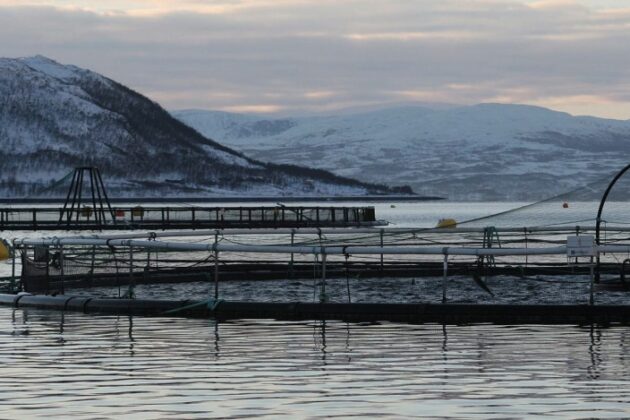Aquaculture sustainability indicators

A web portal with indicators on the sustainability of Norwegian aquaculture was developed. The portal was released in December 2018, and covers more than 20 different themes on environmental, economic and social sustainability. The portal has been replaced by the service AkvaInfo in January 2025.
Start
15. May 2016
End
30. Apr 2024
Funded by
The Norwegian Seafood Research Fund - FHF
Cooperation
SINTEF and BarentsWatch
Project Manager(s):
Other Participants:
Update March 2025
The service “Sustainability in Aquaculture” has been replaced by the service “AkvaInfo,” (https://www.barentswatch.no/akvainfo/) and the website for “Sustainability in Aquaculture” was discontinued in January 2025 (https://www.barentswatch.no/artikler/tjenesten-baerekraft-i-havbruk-avsluttes).
Currently, AkvaInfo provides information at facility and regional levels. Plans are in place to also include data at county and national levels, similar to what was previously available in “Bærekraft i havbruk”.
Nofima has no formal role or responsibility for the AkvaInfo service.
Update March 2023
- New topic page on production permits. You can now view statistics and information about production permits for the farming of salmon and trout, as well as algae, molluscs, crustaceans and echinoderms. These topic pages have an overview of the number of permits, and the production capacity of fish (maximum permitted biomass – MPB) as well. For farming of salmon and trout, the number of different special permits is also shown, such as for fry, broodstock, development etc.
- Data on several of the topics in the Sustainability in Aquaculture portal are now available for individual municipalities. You can search for a municipality by navigating to the Norwegian fish health service and doing a keyword search there (or select it from the map, if the municipality map layer is available), which will display a panel for the municipality in question on the right hand side. On the panel, you can click the button Municipality statistics to view a page containing timelines for a number of relevant indicators for the municipality.
- Many of the charts will allow you to switch data series on and off to get a clearer view of the progress of a single – or a group of – data series.
December 2022 update
The portal Sustainability in Aquaculture presents facts about the effects of aquaculture on environmental, economic and social sustainability, using data from public authorities and research.
- A new topic page in the portal presents the actual production of salmon and trout in Norway and in the individual counties since 1998. It includes information about how the growth in the total harvested amount of salmon and trout in Norway came to a halt in 2012, but later picked up pace again in 2017/18.
- A new topic page on the production of other types of fish than salmon and trout has also been introduced, with brief summaries about the farming of the three most important fish species – cod, halibut and char – and production figures on a county and national level since 2007.
- In addition, another new topic page features facts about mussels and kelp farming. Kelp farming is a relatively new industry, with statistics starting from 2015. For shellfish and other molluscs, crustaceans and echinoderms, production information since 2002 is shown on a county and national level.
September 2022 Update
The theme webpage on area use in the Sustainability in Aquaculture Portal has been updated.
The webpage shows how the total area occupancy for approved sites for salmon and trout farming at sea have developed.
From 2012 to 2021, this area has increased by more than 50 percent. However, the number of sites in Norway is almost unchanged during the period, as shown on the theme webpage.
The number of sites that were not used in various years is also presented. The number of sites can be shown both for Norway as a whole and for the individual counties. The data is updated on a weekly basis.
A dedicated theme webpage for cleaner fish has also been created. It shows the number of cleaner fish released per year and also includes the species of cleaner fish and where they were released. It shows the number of cleaner fish released per year and also includes the species of cleaner fish and where they were released. Figures are available both for Norway as a whole and for individual counties, and data is updated on a monthly basis.
More updates
- Costs – Developments in production costs now include more detailed information about various cost elements.
- Emissions – Results from environmental surveys of the seabed below facilities are now available with data at county level.
- Escapes – The webpage now shows information about all escape incidents for every month over the past two years. Charts show the number of confirmed escaped fish and the number of escape episodes for the entire country and for each county since 2008. The webpage is updated daily.
- Sale of pharmaceuticals – The webpage shows data for several types of pharmaceuticals.
About
The data for the indicators come from official sources and research institutions, and most indicators are updated monthly or yearly. In addition to showing the current situation, the portal also shows developments over time. The portal thus makes facts on how Norwegian aquaculture affects environment, economy and society easily available for a general audience.bout
While the portal as of June 2020 has more than 30 different indicators, new themes and indicators and other improvements are coming. A new theme-page on the greenhouse gas emissions for farmed salmon delivered by different types of transport to markets around the world was added in June 2020.
Researchers from Nofima and SINTEF Ocean developed the portal with support from Barentswatch and Bouvet. Inputs and quality assurance has come from researchers, environmental NGOs and industry actors. The work has been financed by FHF – The Fishery and Aquaculture Industry Research Fund.